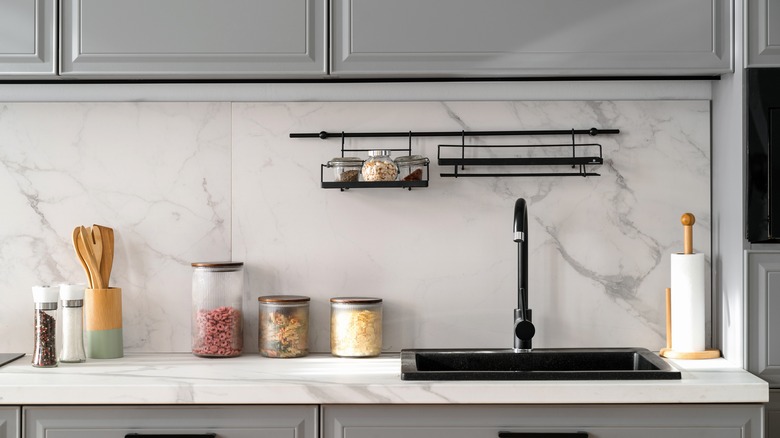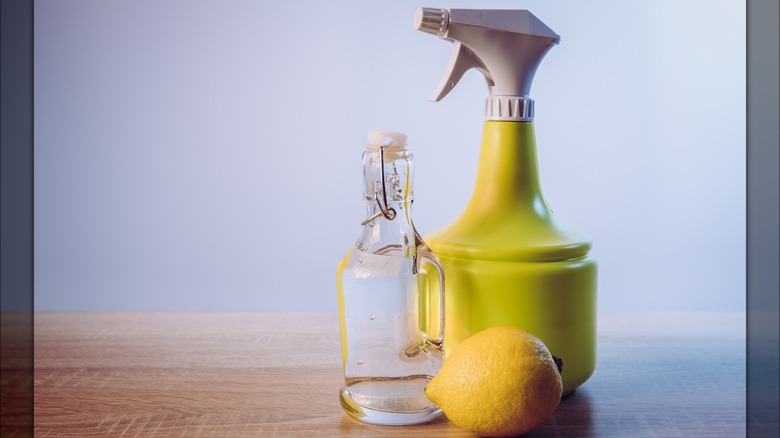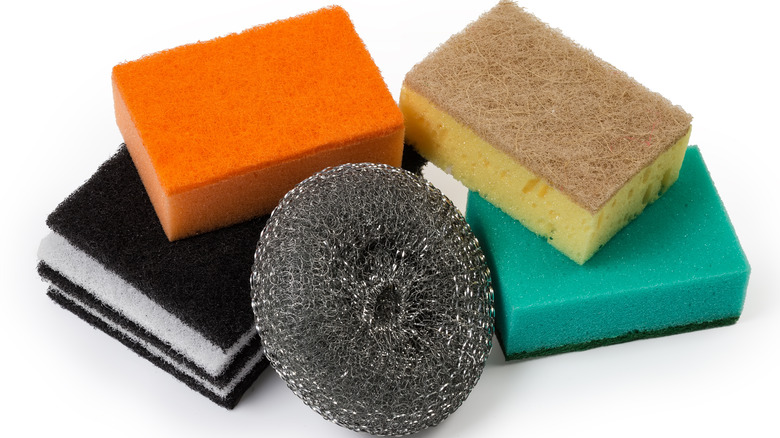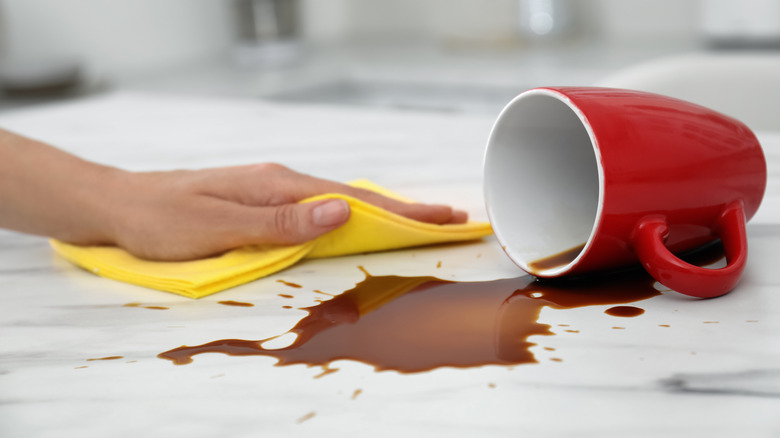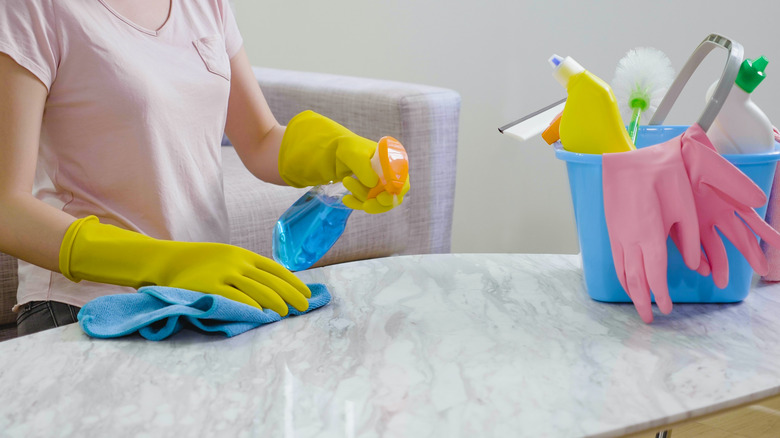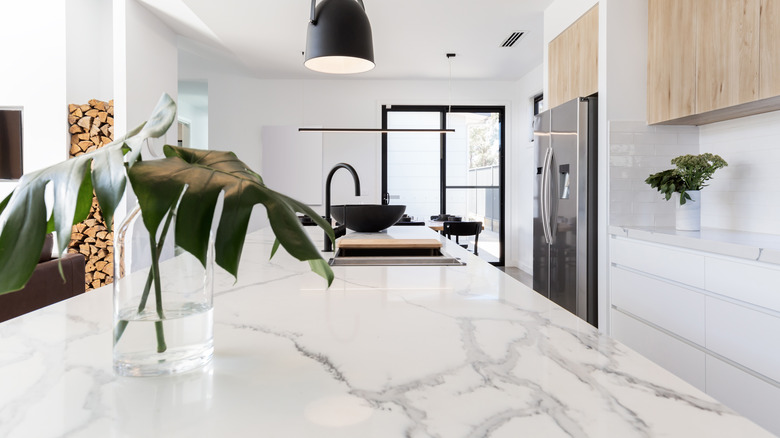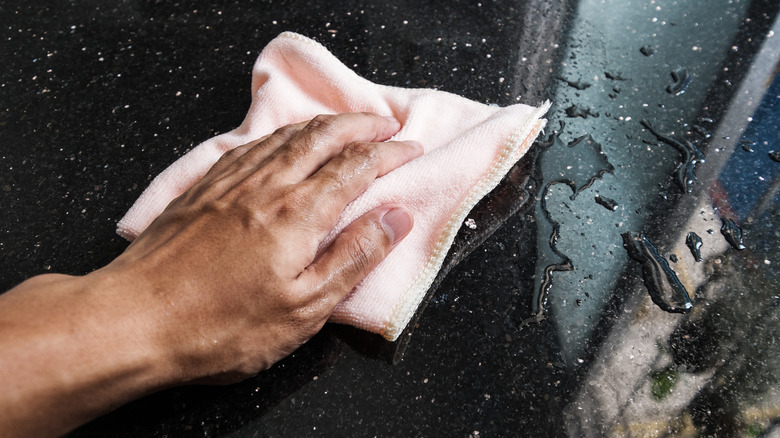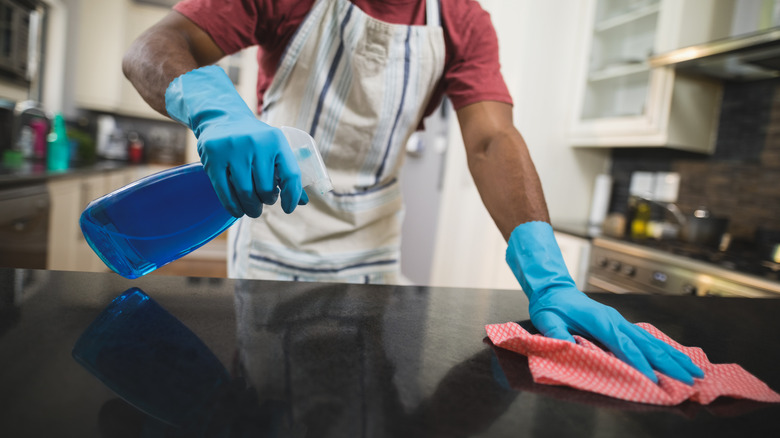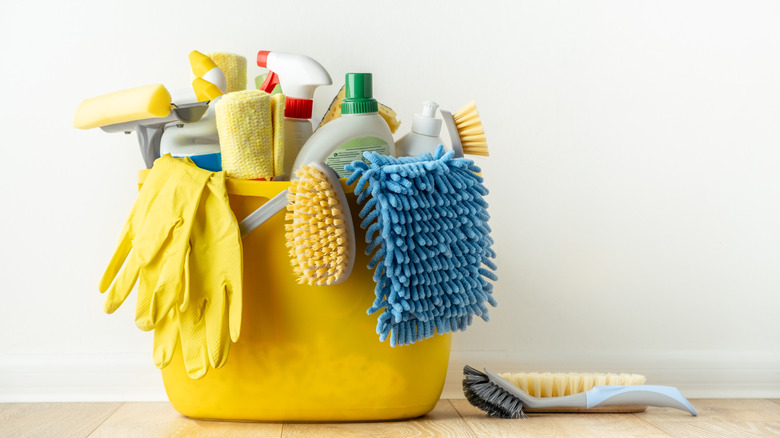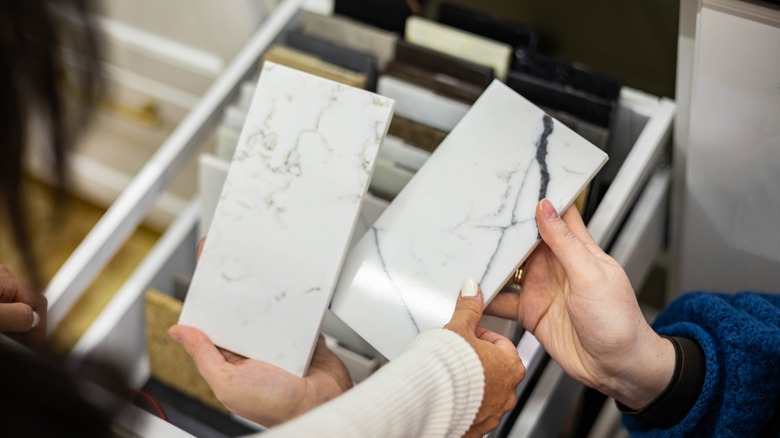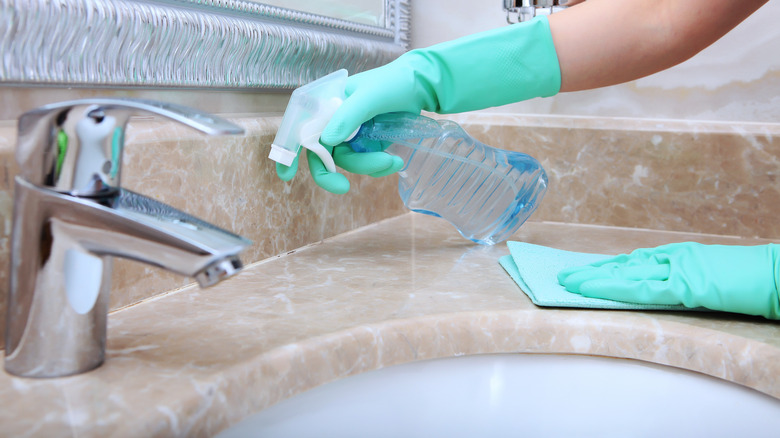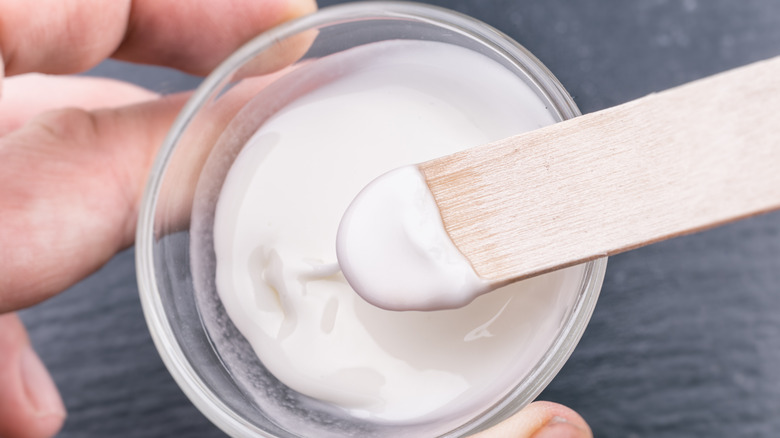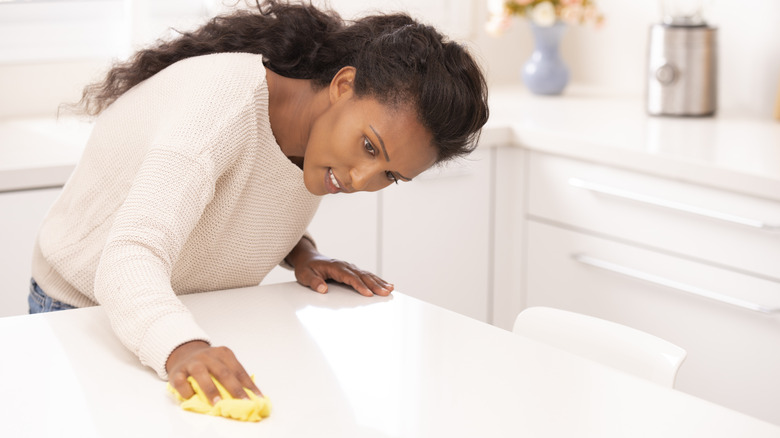All The Common Cleaning Mistakes That Might Be Staining Your Marble
We may receive a commission on purchases made from links.
Marble surfaces offer timeless elegance, and they're a must-have feature in many homes because they bring a touch of luxury to kitchens and bathrooms. While marble's draw is undeniable, understanding how to maintain it is a hurdle many face. Not doing it correctly can dull the marble's surface, removing its natural beauty. However, you can reduce your chances of scratches or stains in your marble by avoiding specific common mistakes when cleaning it. From using acidic cleaners that etch the marble's surface to getting streaks and spots from allowing the marble to air dry, these errors can result in an expensive restoration.
Also, assuming all marble is the same increases your chances of not taking care of it properly, risking more damage. Using generic household cleaners, too much water, or not removing stains correctly can result in a dull and lifeless surface. Learning the right way to care for your counters or flooring ensures they stand out for years. The goal is to shift the focus from essential maintenance to a more nuanced approach to marble care, emphasizing the importance of tailored cleaning methods to preserve its elegance.
Using acidic cleaners on your counters
Grabbing just any cleaner for your marble is a mistake, especially if it's acidic, like lemon juice or vinegar. This is because your marble is mainly made up of calcium carbonate and is very sensitive to contact with acid. When you spray or wipe acidic substances onto your marble, there is a chemical reaction that starts dissolving the calcium carbonate. Also, you get etched surfaces, a physical change that gives you discolored, dull spots where the polished, smooth finish dissolves away. These are more than stains; they're damage to the stone, which could be permanent. Repeatedly using acidic cleaners can worsen this damage, causing your marble surfaces to lose their natural smoothness and polish.
To care for your marble surfaces, choose a pH-neutral cleaning solution specifically made to use on natural stone. Start by finding a cleaner that says it's safe to use on marble, like Marblelife InterCare Marble and Travertine Cleaner. To clean the marble daily, mix warm water with a pH-neutral dish soap, and apply it using a soft cloth or sponge. Carefully wipe the marble to remove any residue or spills, and rinse the surface with clean water to remove any film. Wipe the marble with a soft towel to prevent water stains from forming.
Scrubbing marble surfaces with abrasive sponges
Using abrasive materials like scouring pads or rough sponges like Magic Erasers on your marble to try and get rid of stains can cause a lot of damage. Even though you might think marble is durable because it's stone, it's still prone to scratching since it's relatively soft, rating a 3 out of 10 on the Mohs Scale for stone hardness. When you use abrasive materials on it, you'll create dozens of fine scratches that dull the polish and make it easier to stain. The microscopic scratches you leave from scrubbing the surface are an excellent place for liquids or stains to set in, making it more challenging to clean the marble. Using abrasive materials worsens these scratches, and you'll get a damaged and dull surface that's more prone to wear and has a shorter lifespan.
To keep your marble surfaces looking nice and to maintain their durability, use soft sponges or cloths when you clean them. These materials are gentle enough that they won't scratch the marble, but they're excellent at removing grime and dust. When cleaning, apply your solution to the cloth or sponge and work in a light, circular motion. This will help keep the marble's polished surface intact and stop stains from building up without damaging it. After you clean it, rinse the marble with clear water and use another soft towel to dry it. For tougher stains, contact a professional instead of scrubbing it.
Not cleaning up spills as they happen
One common mistake people make with marble surfaces is not cleaning up spills as soon as they happen. Marble is very porous, meaning it'll absorb whatever you spill on it, especially if it's a deep color or acidic substance. When you leave spills on your marble, even for a few minutes, the liquid starts seeping into the stone, which will etch and stain. The stains are very challenging to get out, and you might need to hire a professional to do it for you. The longer the spill sits, the deeper it'll go into the marble. Therefore, spills require a proactive approach to protect your marble's look.
To prevent stains, blot any spills immediately using a soft cloth. You want to gently press the cloth against the spill to soak up the liquid without spreading it across your marble surface. By blotting the spill, you're minimizing the chances of it getting deeper into your marble. After you blot, use a damp, soft cloth to gently clean and dry the area to remove any leftover moisture. Remember, never rub or scrub at spills; this can push the substance deeper and worsen the problem. If you don't notice the spill when it happens and it ends up staining, don't attempt to scrub it because you can do more damage. Instead, consult a professional.
Using generic household cleaners
Using generic household cleaners on your marble surface can easily cause damage. These cleaners usually have harsh chemicals in their formulas, like alkalis or acids, and they're way too strong for marble's delicate surface. When you apply these cleaners, they react with the marble's calcium carbonate makeup, leading to etching and a dull look. If you repeatedly use them, you can cause irreversible damage. Also, some cleaners will leave a discolored look or stains behind, especially if they have dyes in the formula. Because of this, using these products can compromise your marble's beauty, integrity, and longevity.
To avoid all of the risks of using a generic household cleaner, you want to pick out products with a label that says they're specifically formulated or safe to use on marble. These cleaners come formulated with a pH-neutral makeup, ensuring they'll clean the marble without damaging the surface. Read product labels carefully, paying attention to any recommendations or warnings you see. This ensures whatever cleaner you choose, it'll work with your specific marble type to help preserve the stone's natural beauty. In cases where the appropriate cleaner is uncertain, consulting a professional or the marble manufacturer for recommendations can prevent potential damage.
Skipping sealer application
Not applying a marble sealer as the manufacturer recommends is a part of maintaining these surfaces that some people skip. Marble is very porous by nature, so it can absorb liquids quickly. This is even more true when dealing with acidic substances like lemon juice, wine, or household cleaners. Without the sealer's protective layer, these substances sink into the marble, causing dull spots and discoloration that can be hard to remove. The sealer forms a barrier to reduce the porosity, and this is a thin layer of protection against spills and stains. Not sealing increases the risk of cosmetic damage and leads to more severe structural issues that require expensive repairs or restoration over time.
To protect the marble's surface, you'll want to have your marble sealed regularly. This preventative measure involves a specialized sealer that sinks into the stone and fills the pores to create a protective shield against staining agents. How often you seal it depends on how much you use the surface and how exposed it gets to staining agents. Generally, you should have it sealed every three to 12 months. Regular sealing maintains the polished look and makes it harder to stain, but it doesn't make it completely stain-proof. Talking with a professional about the best type of sealer for your specific marble and how often to have it sealed is critical.
Using too much water
Using excessive amounts of water to clean your marble surfaces isn't a good idea because the marble will absorb the water as it sits. As it seeps in, it causes discoloration or internal damage to the stone, making it less structurally sound. This is an even bigger problem for white or light-colored marble because water can lead to visible stains that detract from the stone's beauty. Prolonged water exposure can cause the marble to crack or spall, and mold and mildew growth are common in the stone's pores. Damage like this impacts the marble's aesthetic appeal, and you may pay a considerable amount to repair or replace it.
To clean marble without the risk of water damage, only wipe the surface down using a damp cloth instead of a wet one. Spray water onto a cloth instead of directly on the marble. This allows you to eliminate spills and dirt without saturating your marble. As you gently wipe down the surface, ensure you're not letting water pool or seep into edges or seams. After you clean it, dry the whole surface with a soft towel to remove any residual moisture and protect it from water-related issues.
Using ammonia-based cleaners
Applying ammonia-based cleaners like Windex will damage your marble. Ammonia is great for cutting through everyday grease and grime on many surfaces, but it's very harsh and will cause a lot of damage to marble in a short time. It's alkaline, so it'll etch the countertop, stripping away the polish and leaving you with a dull surface. Repeatedly using ammonia-based cleaners will cause more wear, making the surface look unclean and worn. The chemical reaction that happens when ammonia hits marble weakens the stone, making it easier to chip, scratch, or crack. This damage also compromises the marble's structural integrity, leading to expensive repairs or replacement in severe cases.
To keep your marble durable and beautiful, stick to cleaning products with a mild, pH-neutral makeup or ones specially designed to use on stone or marble. For everyday cleaning, add warm water to a sponge or soft cloth and use it to wipe the marble. When you finish, rinse with clean water, get a dry, soft cloth, and remove any residue. This helps keep your marble clean and polished without the risk of damaging it that you'd get from using cleaners with harsh chemicals like ammonia.
Mixing cleaning products
There are household chemicals you should never mix together, and one common mistake people make is to combine them to get a stronger cleaning solution to clean marble. A lot of cleaning agents have chemicals that react when mixed. These reactions range from harmful gases to substances that pose health risks and cause damage to the marble. For example, mixing a cleaner with an acid base with bleach releases a toxic chlorine gas. Mixing bleach with ammonia creates chloramine vapors, which are toxic to people and pets. The chemical reactions cause the marble to etch, discolor, and dull the finish.
To stay safe while you clean and keep your marble in good condition, use a single marble cleaner each time you clean it. Using products made for marble guarantees that all ingredients are pH-neutral and free of corrosive substances. These cleaners remove dirt, stains, and spills without stripping away the polish on the marble's surface or causing chemical reactions. If you're unsure about a specific product, contact a marble manufacturer or a professional stone cleaner for suggestions on safe products to use. This careful approach to maintaining your marble surfaces preserves the stone's aesthetic and structural qualities while ensuring a safe environment when you clean.
Assuming all marble is the same
There are different types of marble countertops, and many people mistakenly believe they're all the same and need the same cleaning routines. However, there are several types, and each comes with varying colors, patterns, and porosity levels. For example, softer marbles like Carrara are more prone to staining or etching than harder options like Calacatta. Using a uniform care approach can lead to damage because more porous marble will stain permanently. Additionally, not sealing enough may leave marble varieties that are less dense vulnerable to damage.
To ensure you care for your marble correctly, you must know which type of marble you have. The specific type will impact your care and maintenance routine. Different marbles need varying sealing frequencies to protect from etching and staining. Also, specific cleaning agents may work better for different marble types. Researching or talking to a marble care professional will give you valuable information about your marble's requirements. Choose cleaners and sealants, and create a maintenance routine that corresponds to your stone's unique demands to keep it looking pristine.
Using too much cleaner
Too many products on your marble can cause issues. While you may think that more cleaner means you'll get a cleaner surface, the opposite is true. Adding too much cleaner can cause a sticky film to build up that reduces the marble's shine, and acts like a dust and dirt magnet. Over time, the grimy build-up can embed into the marble's surface, making it look dull. Additionally, the wrong cleaning products have chemicals that can degrade the marble's surface if you leave them sitting on it. This residue causes staining and etching, especially with alkaline or acidic cleaners. You may end up cleaning more or scrubbing harder to remove it, speeding up wear and tear.
To avoid this mistake, read the labels and see what the company recommends for a dilution ratio before you use it. Following the directions and only using the recommended cleaner ensures it's effective without leaving a sticky residue. In many cases, cleaning more frequently using less product is better for the marble's surface than pouring on too much cleaner at once. After washing, always rinse the surface with clean water to remove any lingering cleaning solution.
Applying too much pressure when removing stains
Using too much pressure and scrubbing hard at stains to remove them is common, but it causes more damage to marble instead of lifting the stain. Marble is relatively easy to damage due to its makeup, so aggressively cleaning it can cause you to scratch the surface. Scratches create tiny crevices in the marble, and dirt and grime can get caught and build up, worsening the problem.
To remove stains without damaging the marble, create a poultice for use on marble. A poultice is a paste-like substance that, when applied to a stain, pulls the discoloration from the marble by absorbing it. A simple poultice can be made from baking soda and water. To use a poultice, spread it out evenly over the stain, going slightly beyond the edges. If advised, cover it with a plastic wrap. Let the poultice sit on the stained area for the time the product specifies, which could be a few hours to overnight. Afterward, use a damp, soft cloth to gently remove the poultice without scrubbing. Patience is vital with poultices; they are designed to work over time to lift the stain from the marble gently. In some cases, a second application may be necessary for stubborn stains.
Not drying the marble entirely after cleaning
Since marble countertops are beautiful but stain easily, it's common to spend a decent amount of time cleaning them, but skipping drying it is a mistake you don't want to make. Letting marble air dry, especially if you have hard water, causes water streaks and spots. As the water evaporates, the minerals it leaves behind stain the finish. Over time, the water spots get more challenging to remove, requiring a more aggressive cleaning method that damages the marble. Also, in areas that have water with higher mineral content, the residues have a chemical reaction with the marble, leading to dulling. This can significantly detract from the natural beauty and value of the marble, making it appear poorly maintained.
To keep your marble shiny and avoid water spots or streaks, dry the surface thoroughly with a soft cloth each time you clean or wash it. Use a lint-free, soft cloth and gently wipe or pat the marble dry. Don't give the water time to evaporate. Also, ensure that you don't use a lot of pressure when you wipe the water away because doing so can accidentally etch the surface.
